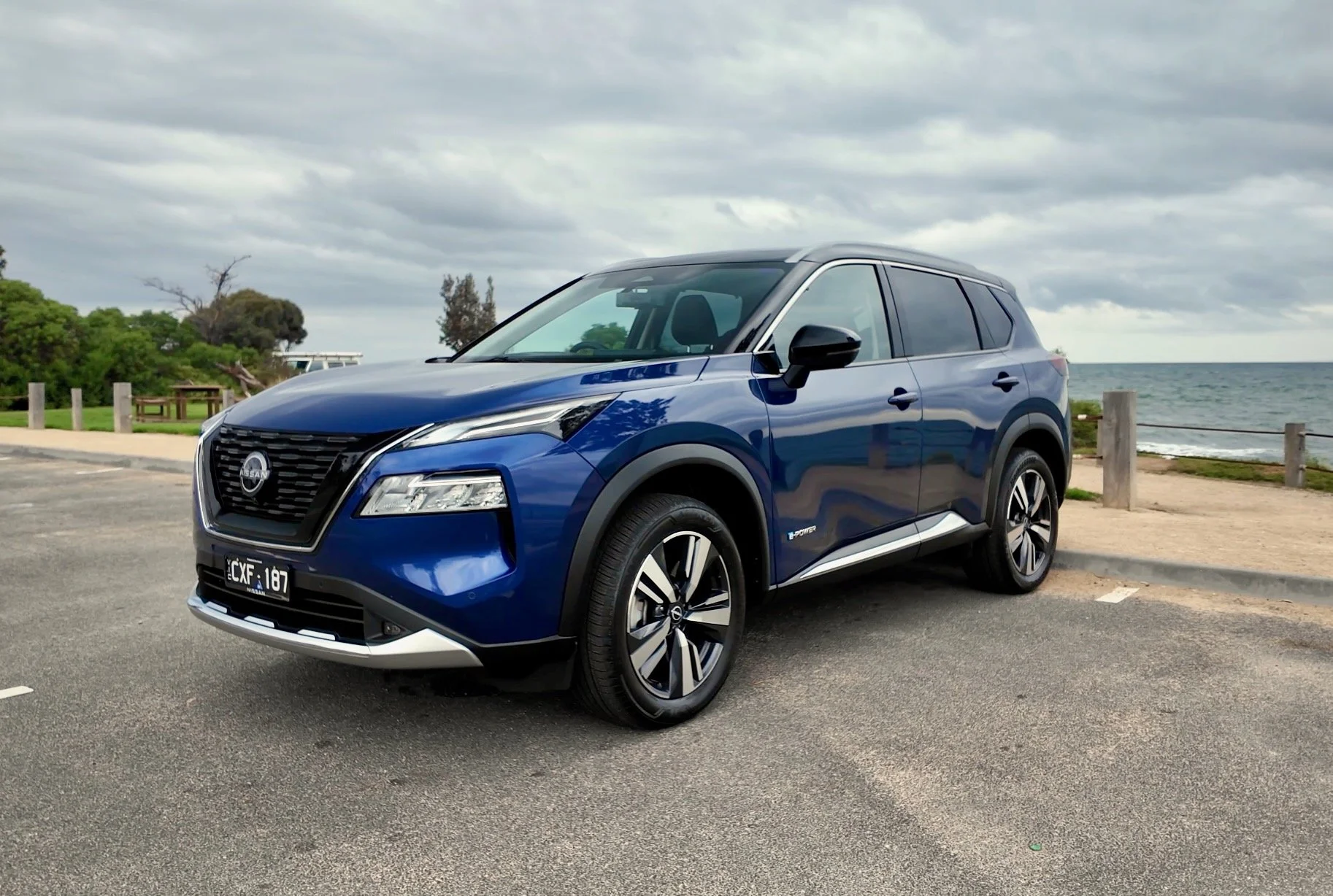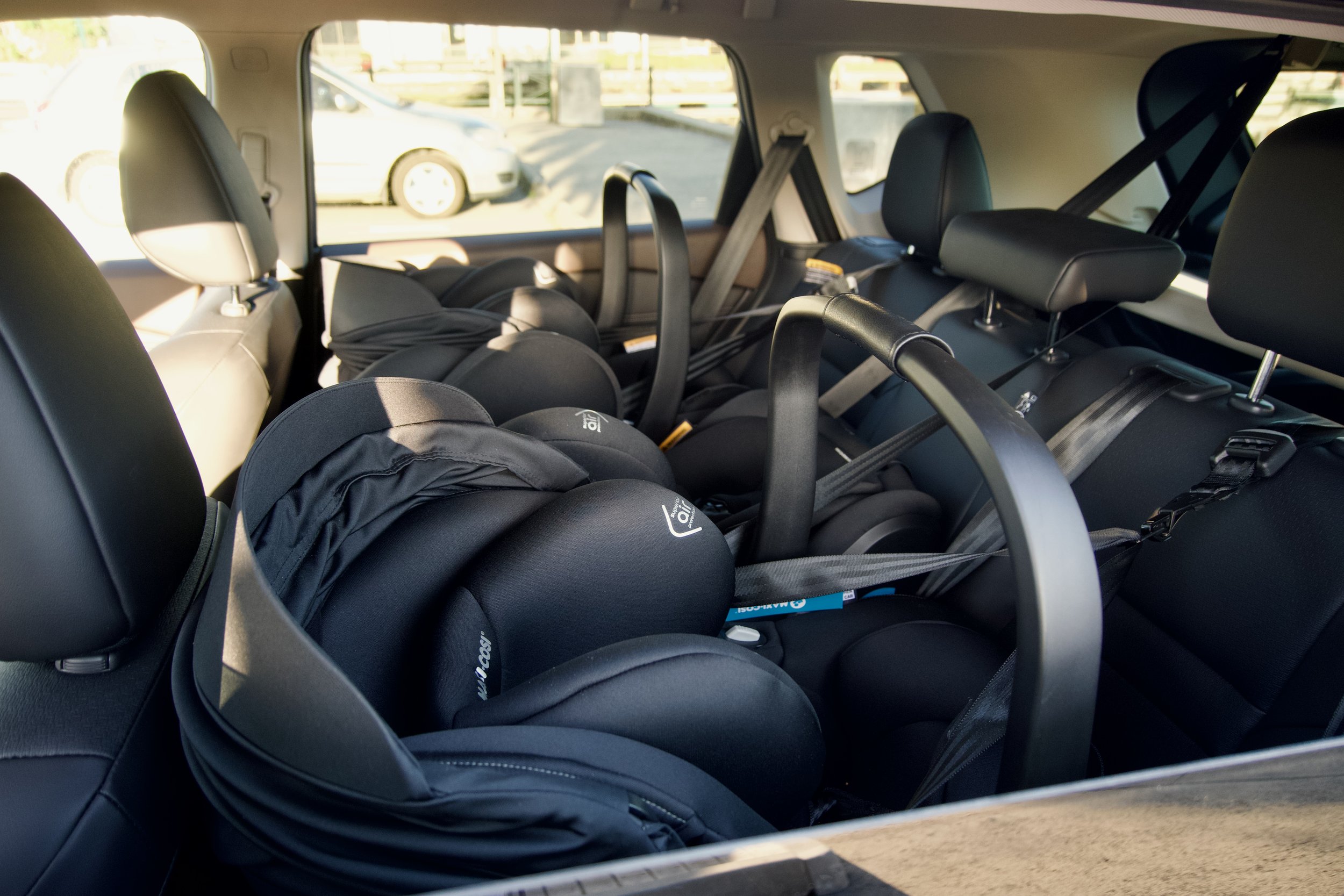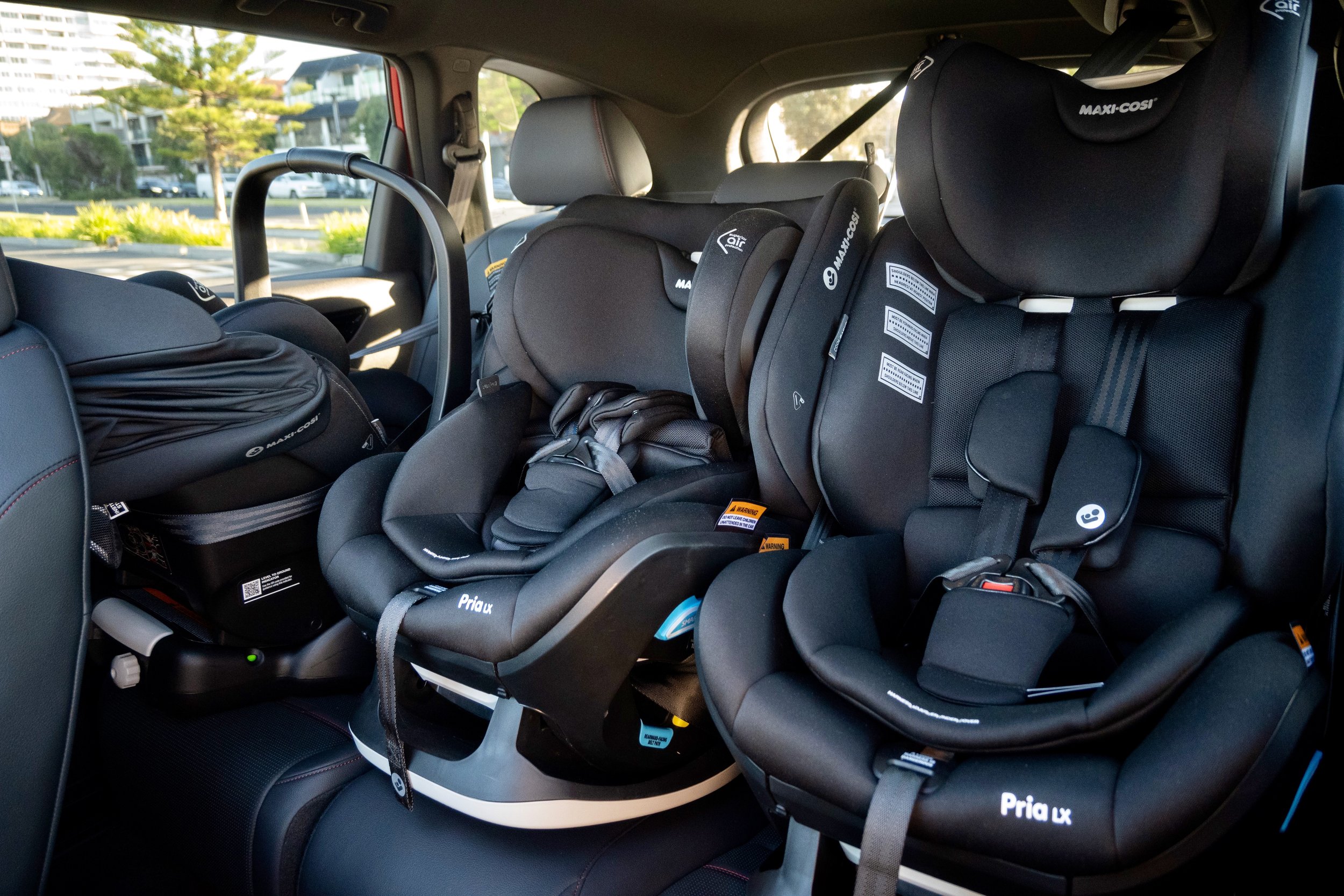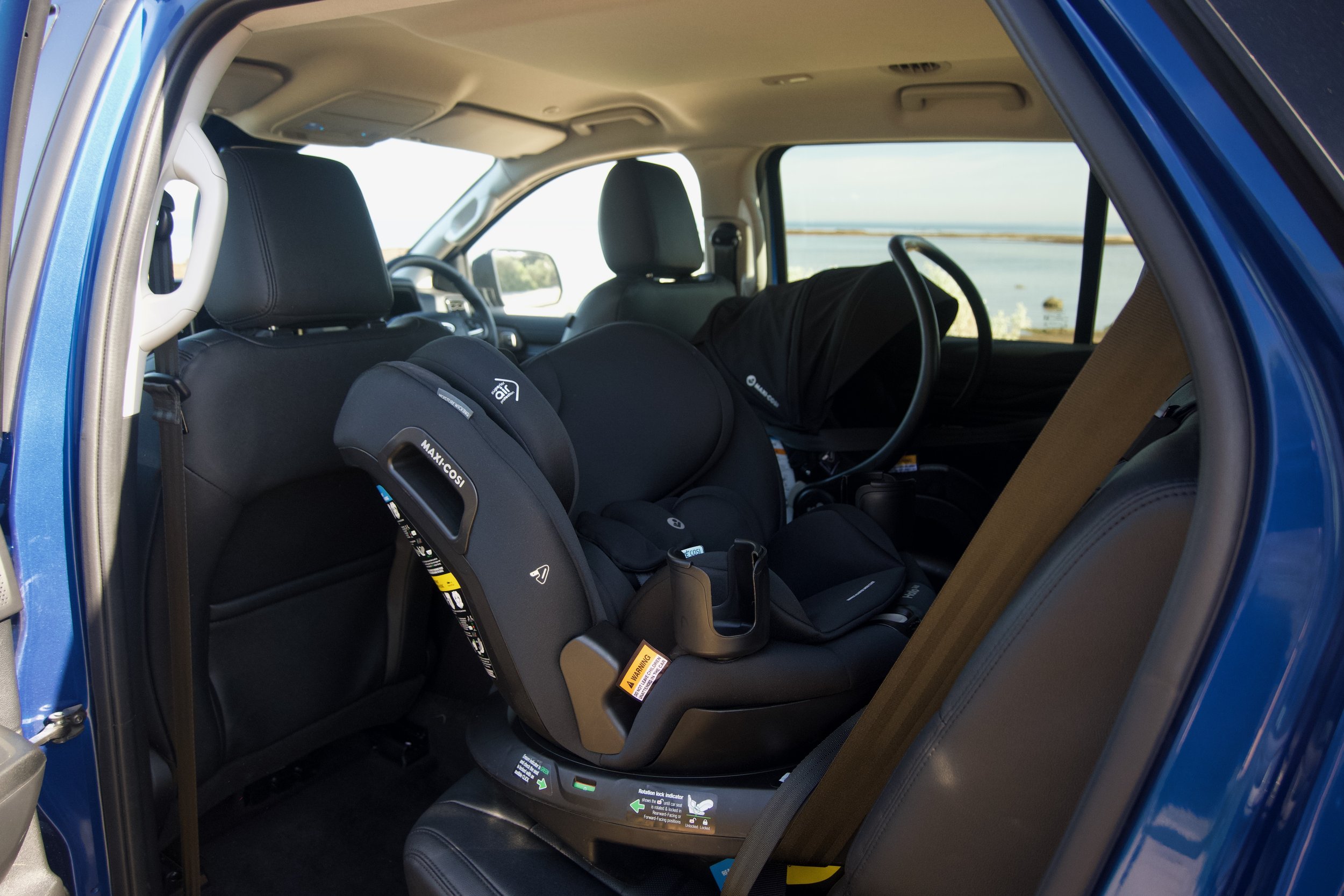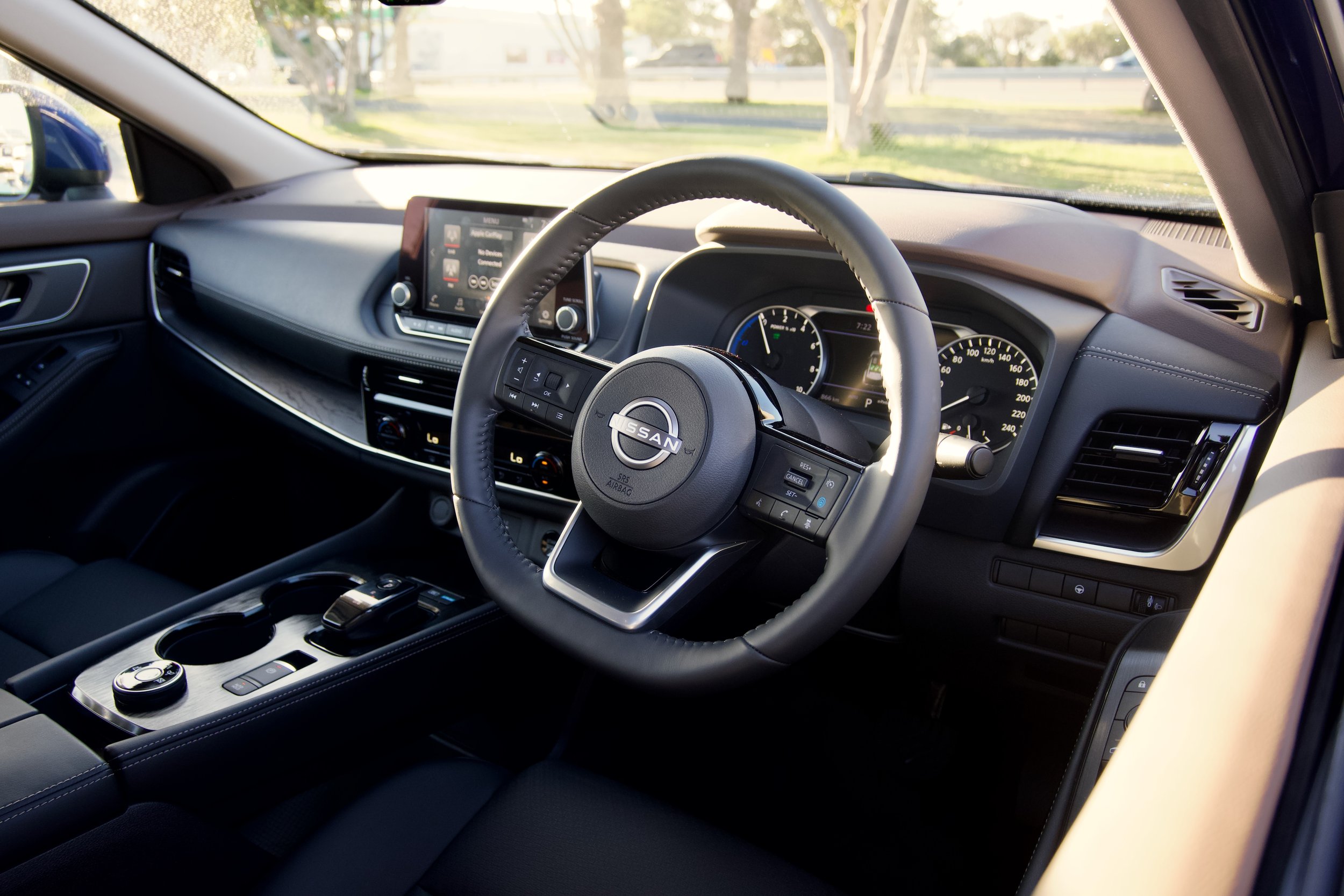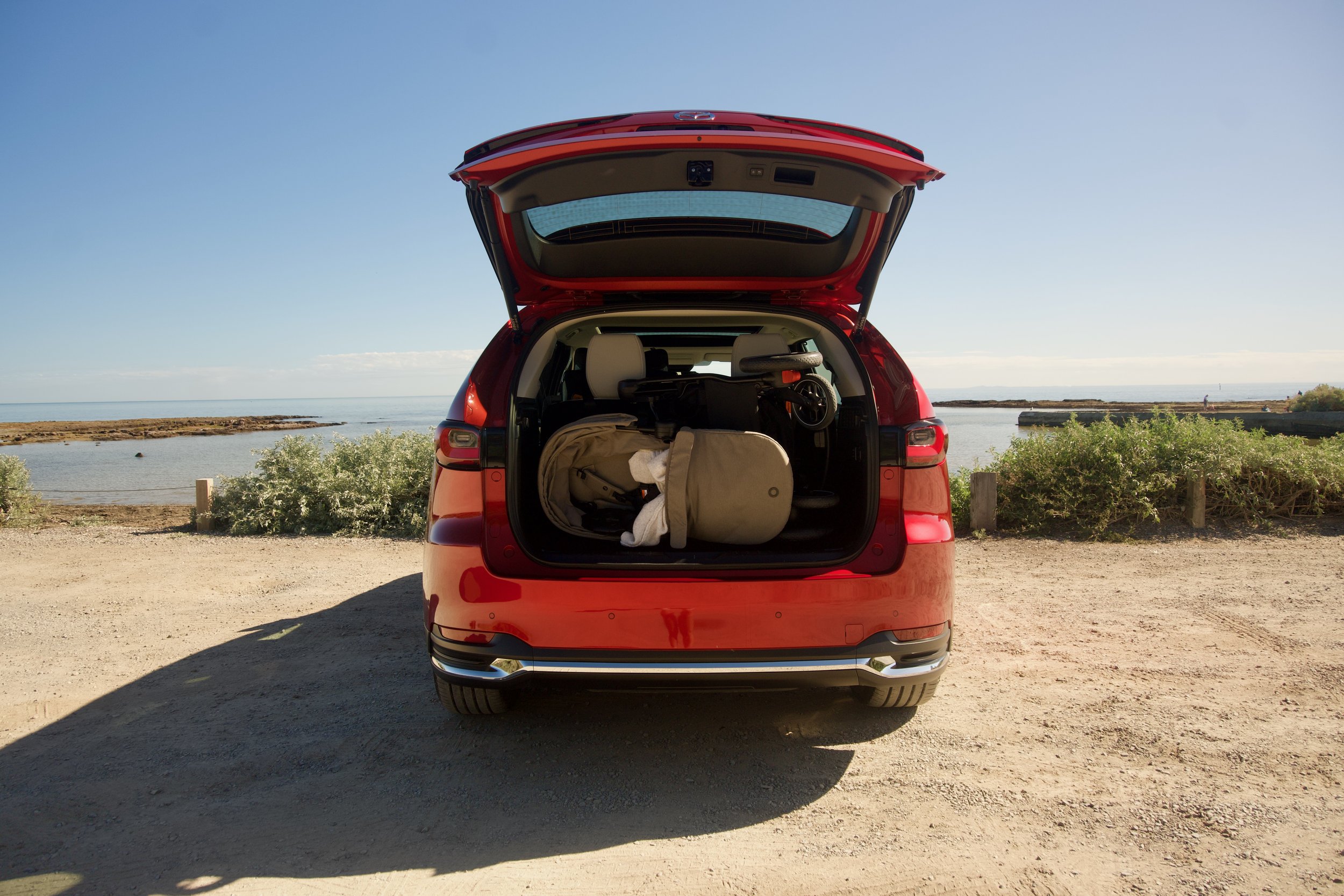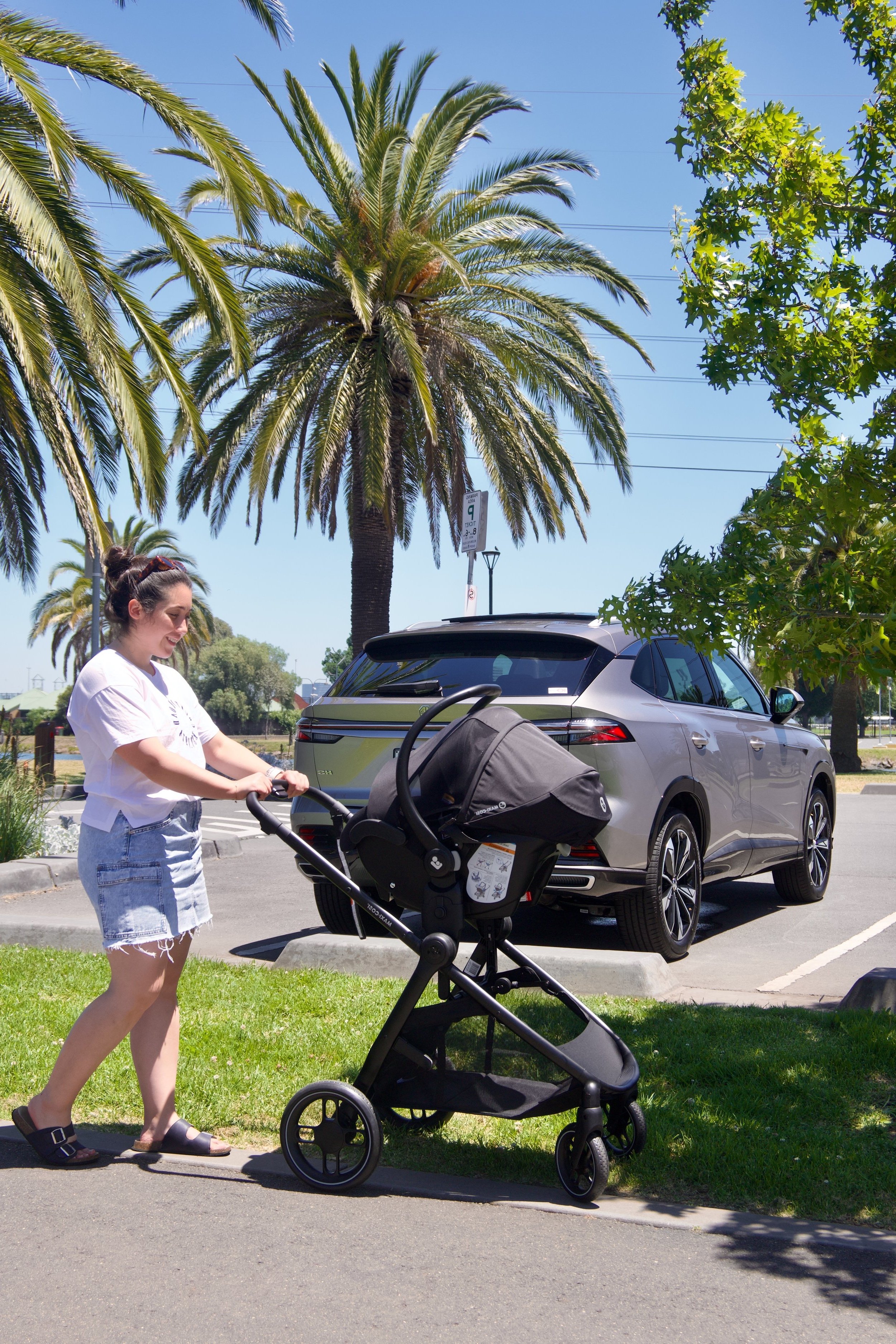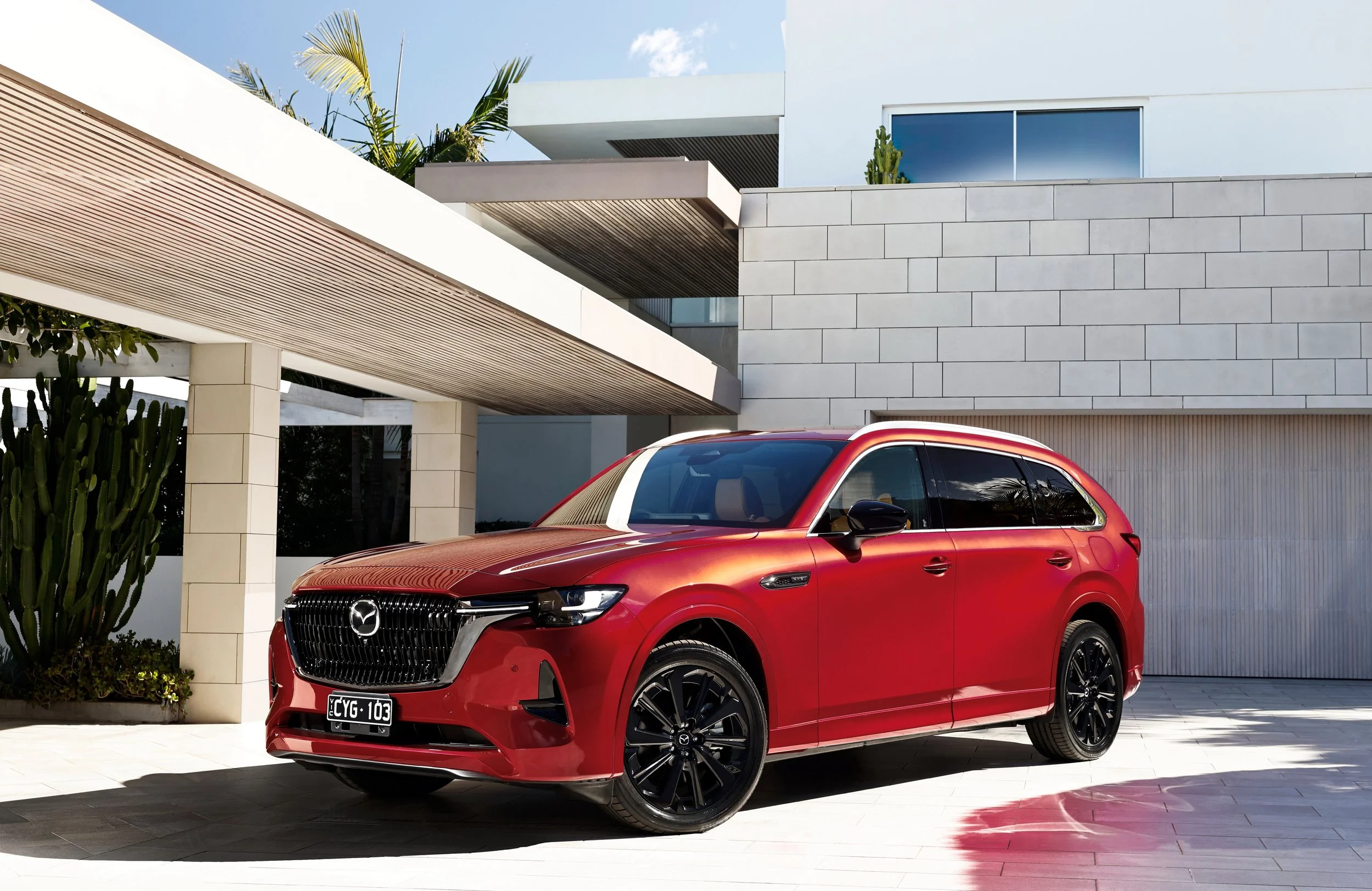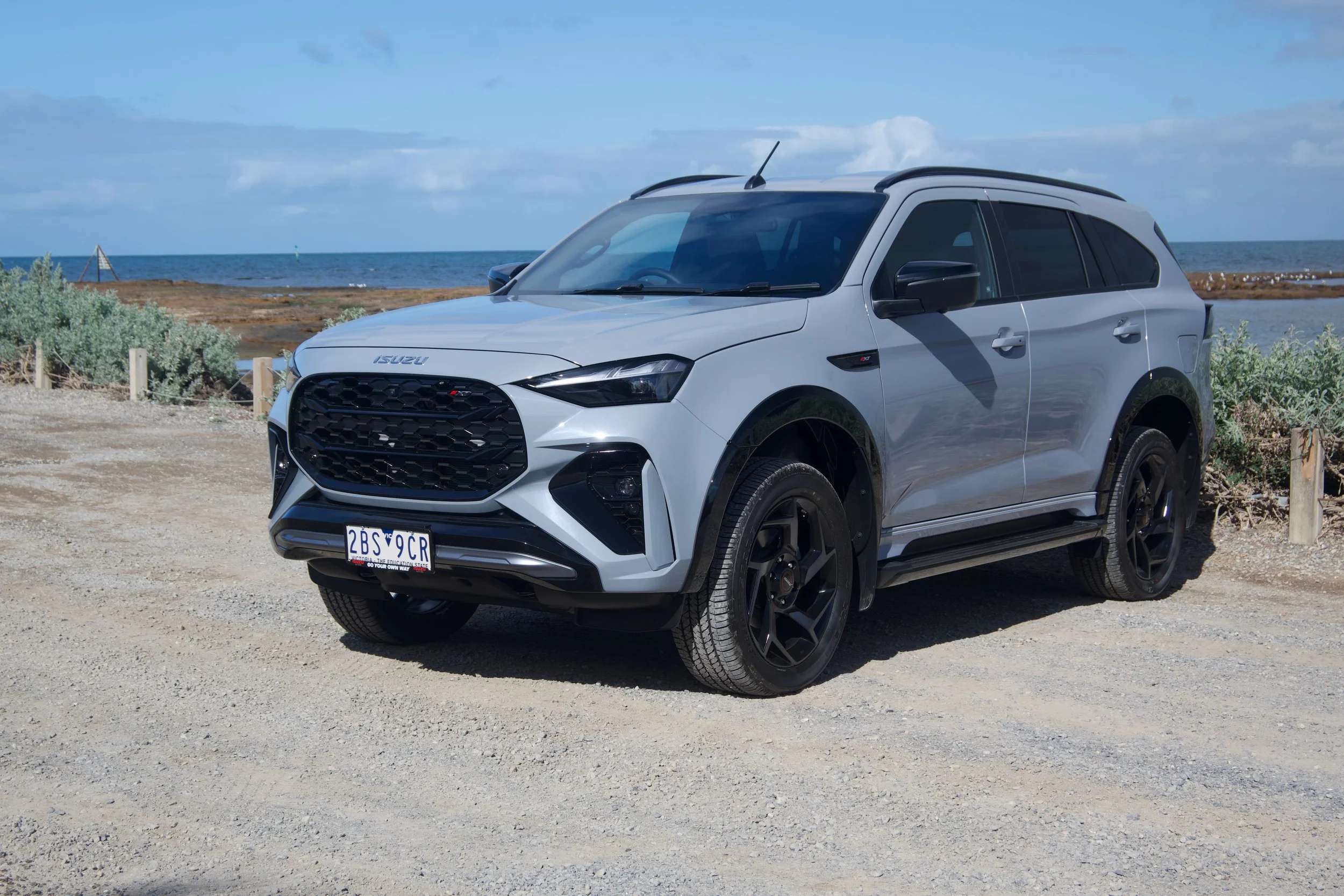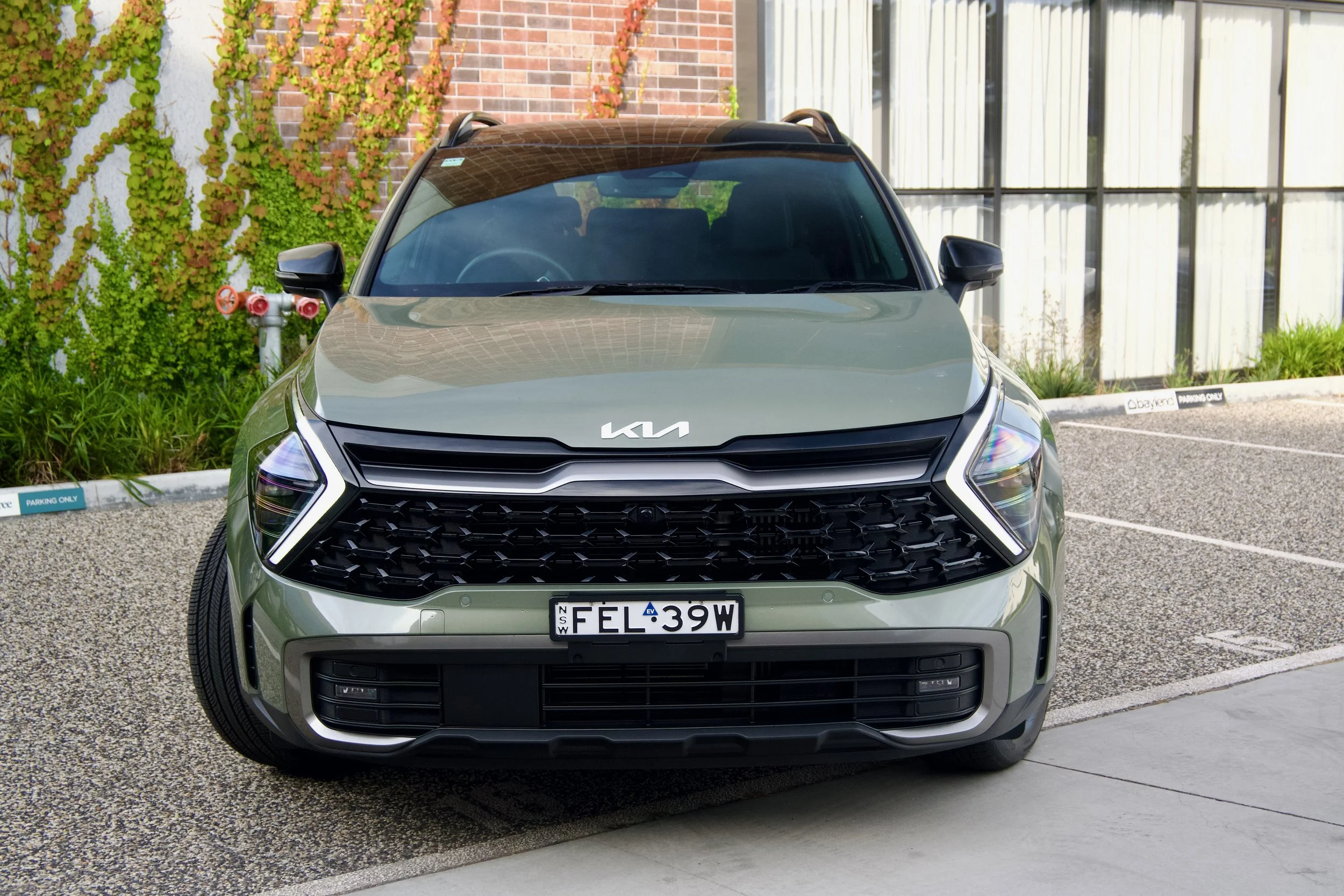2025 Nissan X-Trail family review: Why isn’t anyone talking about this hybrid SUV?
If you’re looking for a five-seat, fuel-efficient, tech-filled and genuinely practical mid-size SUV for your family, the Nissan X-Trail—particularly in the Ti-L hybrid trim—is well worth a closer look.
You can get the X-Trail as a petrol or hybrid, and either as a 5 or 7-seater. Nissan’s hybrid tech is called e-POWER, which means the wheels are powered by an electric motor, but you never plug it in—there’s a petrol engine that charges the battery as you drive. Paired with e-4ORCE –Nissan’s all-wheel drive tech, it makes for a comfortable and quiet ride, either in the city or on long outer city journeys.
We spent a week with the top-spec 5-seat hybrid, and used it just like a family would—doing school drop-offs, running errands, and fitting two baby capsules and a toddler car seat. We found it handled it all really well. The petrol engine kicks in seamlessly when you need a bit more power but will be prioritise the electric motor for small trips to and from daily drop-offs and work.
The X-Trail's doors open to 90 degrees, making it much easier to get kids and capsules in and out, and there’s enough rear-seat space to install three across—yes, including two rear-facing capsules - quite rare for a 5 seater SUV. Storage isn’t an issue for a two-to-three-child family, especially in the boot. A full-size pram and 4-5 shopping bags fit without drama.
Earlier this year, Nissan moved to a 10-year/300,000km warranty, which makes it an even stronger buying option if you’re thinking long-term.
Compared with similar options like the Mitsubishi Outlander or Honda CR-V hybrid, the X-Trail stands out for thoughtful family features—things like built-in window shades, heated rear seats, and tri-zone climate control, all of which are in the top-model Ti-L.
Did you know Baby and Car uses a trusted network of dealerships Australia-wide to find you the best price for your next brand new car? With tailored Australian-based support, enquire today. Find out more here.
Nissan X-Trail pros & cons: What you should know before buying
Pros:
3 rear-facing child seats fit in the second row: This is quite rare for a mid-size SUV.
Underfloor boot storage: Perfect for things you don’t need everyday but want to have for emergencies.
10-year/300,000km Nissan warranty: One of the best warranty periods available in Australia
90-degree rear door openings: Another quite rare feature, Mazda’s can do this too but pricing is more expensive for the CX-60 and CX-70.
Hybrid system is quiet and responsive
Cons:
Middle top tether point is roof-mounted: Not a deal breaker for some but I found it to be a little annoying as it mildly obstructs the view from the rear windscreen.
No top tether points in the third row: If you choose the 7-seater, the third row isn’t great for adults traveling longer than 10-15 minutes, making the third row for children above seven years old who don’t require a top-tethered seat.
Centre seat in second row is narrow: This might limit access to the third row – from the second – when car seats are installed
Hybrid model costs more upfront, even though it’s efficient:
Need a car seat installed? We’re here to help…
Nissan X-Trail price guide – How much does the 2025 Nissan X-Trail cost?
The Nissan X-Trail is available in five trim levels, and two powertrain options and two drivetrain options: 2WD and AWD, all together offering 11 variants. Pricing as follows:
2025 Nissan X-Trail ST 2WD: $36,990 before on-road costs
2025 Nissan X-Trail ST AWD: $39,990 before on-road costs
2025 Nissan X-Trail ST-L 2WD: $41,465 before on-road costs
2025 Nissan X-Trail ST-L AWD: $44,565 before on-road costs
2025 Nissan X-Trail N-Trek 2WD: $46,060 before on-road costs
2025 Nissan X-Trail ST-L e-power AWD: $47,765 before on-road costs
2025 Nissan X-Trail N-Trek AWD: $49,160 before on-road costs
2025 Nissan X-Trail Ti AWD: $50,265 before on-road costs
2025 Nissan X-Trail Ti e-power AWD: $53,265 before on-road costs
2025 Nissan X-Trail Ti-L AWD: $53,265 before on-road costs
2025 Nissan X-Trail Ti-L e-power AWD: $57,065 before on-road costs (as tested)
(Exact driveway pricing will vary depending on location and registration type; check with Nissan Australia or your local dealership for up-to-date costs.)
Want to save money? Baby and Car uses a trusted network of dealerships Australia-wide to find you the best price for your next brand new car. With tailored Australian-based support, it’s free to get a quote. Find out more here.
Nissan X-Trail engine options: Petrol or Hybrid
The 2025 Nissan X-Trail comes with two powertrain and two drivetrain options:
2025 Nissan X-Trail 2.5L four-cylinder petrol: 135kW of power & 244Nm of torque
2025 Nissan X-Trail 1.5L three-cylinder petrol hybrid e-Power: 157kw of power from the electric motor and 106kW of power and 250Nm of torque from the petrol engine.
When it comes to choosing between the engine options in the 2025 Nissan X-Trail, there are two available: a 2.5-litre four-cylinder petrol engine, and what Nissan calls e-POWER. I drove the top-spec Ti-L e-POWER version with all-wheel drive (Nissan calls it e-4ORCE), and it’s definitely not your standard hybrid SUV setup. So if you’re wondering what e-POWER is and how it compares to a regular petrol X-Trail, here’s how it actually works in everyday family driving.
The Nissan X-Trail hybrid system is a bit different to most other hybrid family SUVs in Australia. In this setup, the wheels are powered solely by an electric motor—so you get that smooth, quiet electric drive feel straight away when you accelerate. But you never have to plug it in. Instead, there’s a small petrol engine under the bonnet that charges the battery while you drive.
In real-world driving with the 2025 Nissan X-Trail Ti-L hybrid, the system felt smooth and responsive. I used it for everything from school drop-offs and city errands to a highway trip down the coast, and I noticed the electric motor kicked in quickly when I needed extra power—like overtaking or getting through an a large intersection just as the orange light struck. The hybrid system delivered torque instantly, with no delay or lag. The petrol engine does become noticeable occasionally, especially when it’s charging the battery at a standstill with the air-con running, but no more than any other hybrid SUV on the market.
I mostly left the drive mode set to Auto during the week and didn’t really feel the need to switch into Eco or Sport. Nissan does have an e-Pedal step feature, which allows for one-pedal driving above 10km/h, but that’s not for me in general.
In terms of fuel economy, I averaged 5.9L/100km over 289 kilometres and 9.26 hours of mixed driving—beating Nissan’s official combined figure of 6.1L/100km. That was with all the car seats, prams and everyday stuff in the car, plenty of stop-start trips and a full boot, so it’s a strong result. If you’re mostly doing urban driving, short daycare runs, or school pickups, this hybrid setup is really efficient.
The regenerative braking in stop-start traffic helps charge the battery and reduces how often the petrol engine needs to work, which is great for keeping fuel costs down. Compared to the petrol-only X-Trail, which I’ve also driven before, the hybrid is noticeably more refined. The regular petrol engine is fine, but once you get used to the quietness of a hybrid it’s hard to go back. The hybrid also handles that more effortlessly, and the extra torque really improves the overall drive feel.
If you’re trying to decide between the 2025 Nissan X-Trail petrol vs hybrid for your family, I’d say the hybrid wins on smoothness, responsiveness, and day-to-day fuel savings—especially if your lifestyle involves a lot of short trips and city driving. It’s also nice knowing you don’t have to change how you drive or where you refuel. It still runs on 91 RON petrol but for the e-Power Nissan recommends 95 RON.
When you add in Nissan’s new 10-year/300,000km warranty, the X-Trail hybrid becomes a strong value choice for growing families looking for a quiet, efficient, and family-ready SUV that doesn’t require a lot of compromise.
Check out other Baby and Car content:
Is the Nissan X-Trail fuel-efficient?
The 2025 Nissan X-Trail offers two engine options. Here are the official fuel consumption figures:
2.5-litre 4 cylinder petrol engine FWD: 7.4L/100 (combined)
2.5-litre 4 cylinder petrol engine AWD: 7.8L/100 (combined)
1.5-litre 3 cylinder hybrid petrol engine: 6.1L/100km (combined)
When it comes to fuel efficiency in the 2025 Nissan X-Trail, the hybrid e-POWER system will see a big difference if saving fuel is your number one priority.
We tested the X-Trail Ti-L hybrid SUV across a mix of city commutes, school runs, highway trips and errands, at the end the week, the real-world fuel economy came in at 5.9L/100km, which actually beats Nissan’s official combined figure of 6.1L/100km. We reset the trip computer at the beginning of the test, left it in Auto drive mode the entire time (not even Eco mode), and the car had just over 5,000km on the odometer, so it was nicely run-in.
The Nissan X-Trail hybrid doesn’t need to be plugged in—it uses a petrol engine to charge the battery, and then drives using electric power only. This makes it a great option for families who want the feel and efficiency of an EV without needing home charging. Compared to traditional petrol SUVs, the X-Trail hybrid’s fuel consumption is noticeably lower in everyday use, especially if you’re mostly doing short trips or stop-start city driving. In fact, the regenerative braking system in the X-Trail hybrid helps keep the battery topped up while you drive, so the petrol engine doesn’t need to do all the work.
Although we didn’t test towing or driving with a roof pod, like any SUV, you can expect fuel efficiency to vary under heavier load conditions. However, for regular family life—think groceries, daycare runs, and weekends out—the Nissan X-Trail hybrid fuel economy is great for a mid-size family SUV in Australia. It also helps that it doesn’t feel like a ‘budget’ option—thanks to all the safety and tech in the Ti-L model.
It’s worth noting when we reviewed the Kia Sportage hybrid we achieved 5.0L/100km whereas the Toyota RAV4 come in around 5.7L/100km.
Nissan X-Trail towing capacity: Can it handle a caravan?
2.5-litre 4 cylinder petrol engine FWD and AWD: 2000kgs
1.5-litre 3 cylinder hybrid petrol engine: 1650kgs
When it comes to towing capacity in the 2025 Nissan X-Trail, it depends on which engine you choose.
The 2.5L petrol X-Trail offers up to 2000kg braked towing capacity, which is on par with many competitors in the mid-size SUV segment. The hybrid e-POWER version has a slightly lower rating of 1650kg, which still puts it ahead of the Toyota RAV4 AWD hybrid, rated at 1500kg but in line with the Hyundai Tucson and Kia Sportage respective hybrids.
Nissan X-Trail interior & space: How practical is it for families?
When it comes to family practicality, the 2025 Nissan X-Trail Ti-L hybrid is a versatile and family-focused midsize SUV. If you're searching for a hybrid SUV that fits three child seats, this is one of the rare options that can do it.
We tested the 5-seat Nissan X-Trail hybrid and successfully installed three rear-facing car seats across the second row—using the Maxi Cosi Mico Plus, Mico 12LX, and Pria LX—which many families with babies or toddlers will know is a tough ask. The second row includes two ISOFIX points and three top tether anchors, although it’s worth noting that the centre top tether is mounted on the roof, similar to the Honda CR-V and Mitsubishi Outlander.
It's a little awkward to reach, but once it's clicked in, it stays put. We recommend using slimline car seats and install them with the seatbelt instead of ISOFIX, you’ll give yourself the best chance at making it work.
The X-Trail’s wide-opening rear doors (90 degrees) are a huge win for parents, making it easier to get kids in and out of their car seats without twisting or bumping elbows. The seat height has also been considered in mind for toddlers and young children to climb in and out on their own—especially for families with two or three kids under 10. If you’re thinking about using the centre seat for a child without a restraint, it’s fine for younger passengers but we found it a little too tight for adults on longer drives. Like many 5-seater SUVs for families, it’s something to plan around.
A few special touches included build in sunshades, a very large centre console storage bin, and the underfloor stoage in the boot.
Boot space in the 2025 Nissan X-Trail hybrid is another tick for parents. We were able to fit a full-sized Maxi Cosi Mali pram and 4–5 shopping bags with no issues, and there’s underfloor storage for first aid kits, emergency nappies and wipes or anything you don’t need easy access to every day. The boot floor sits below hip height (I’m 5'3"), making it easier to lift in heavy prams or groceries without straining your back.
If you're comparing boot space in hybrid SUVs, the X-Trail has s similar boot size to the Toyota RAV4 hybrid (580L) and Kia Sportage (586L). The petrol models have 585L while the hybrid drops down to 575L to allow for space for the electric battery.
The powered tailgate with a kick sensor is especially helpful when you’ve got your hands full or need to quickly open the boot in a tight car park.
From the driver’s seat, visibility in the 5-seat X-Trail hybrid is great—even with the second row fully loaded. We didn’t notice any major blind spots, and although the 7-seat Nissan X-Trail has a different seating layout and we can’t verify visibility out the back windscreen, we’d still lean toward the 5-seat version for everyday family use, especially given the lack of top tethers in the third row.
Want to save money? Baby and Car uses a trusted network of dealerships Australia-wide to find you the best price for your next brand new car. With tailored Australian-based support, it’s free to get a quote. Find out more here.
Nissan X-Trail boot space & storage: How much can it fit?
With 5 seats up: 575L-585L
With 7 seat configuration but only 5 seats in use (third row down): 465L
Boot space in the 2025 Nissan X-Trail is well-suited to family life, especially in the 5-seat configuration. With all five seats up, you get between 575 to 585 litres of boot capacity, which is enough to comfortably fit a full-size pram, nappy bag, and multiple shopping bags—a key consideration for families comparing midsize SUVs. If you're looking at the 7-seat X-Trail but plan to keep the third row folded most of the time, you'll get 465 litres of cargo space with five seats in use, which is still usable but noticeably tighter. Whether you need room for sports gear, a double pram, or weekend luggage, the Nissan X-Trail boot space stacks up well against rivals like the Toyota RAV4 (580L) and Hyundai Tucson.
Note: Nissan doesn’t quote the boot space capacity of the seven seater with all three rows in use.
In the market for a new car? Get one on one support with Baby and Car
Nissan X-Trail safety features: Is it a safe family car?
When it comes to choosing a family SUV in Australia, safety is one of the most important factors—and the 2025 Nissan X-Trail delivers a comprehensive suite of advanced driver assistance systems across the entire range. From autonomous emergency braking and lane-keeping technology to features like a 360-degree camera on higher trims, the X-Trail covers all the key safety tech families are looking for.
Standard across the whole range is the following safety features:
Autonomous emergency braking with pedestrian, cyclist and junction detection
Rear automatic braking
Forward collision warning
Reverse parking sensors
Driver attention alert
Intelligent lane intervention
Blind spot warning
Rear cross traffic alert
Traffic sign recognition
Hill start assist
Spare tyre (excluding hybrid models)
Driver alert
7 airbags (front, side, curtain, and front centre)
Emergency braking
Blind spot intervention
Lane trace control with cornering brake assist
Lane departure warning
Lane keep assist
Rear-view camera
Approach unlock and walkway lock
Nissan X-Trail ST-L adds:
Front parking sensors
Tyre pressure monitoring system
Adaptive cruise control
Lane centring and traffic jam pilot (available on ST-L petrol and hybrid Ti/Ti-L)
360-degree around view monitor with moving object detection
Rear parking sensors upgraded to front and rear sonar system
Nissan X-Trail X-Trek adds:
10.8-inch heads-up display
Built in rear-sunshades (only available on N-Trek and Ti-L models)
Nissan X-Trail Ti adds:
Heads-up display
Digital rear-view mirror
Traffic sign recognition with overspeed warning
Forward collision warning
Adaptive LED headlights with high beam assist
Nissan X-Trail Ti-L adds:
Remote engine start (hybrid only)
Memory function for driver seat and mirrors (linked to key fob)
Additional camera and radar-based calibration
ANCAP rating: The Nissan X-Trail has a five-star ANCAP safety rating.
The 2025 Nissan X-Trail Ti-L e-POWER Hybrid offers a comprehensive safety technology suite which is on par with most mid-size family SUVs in Australia.
Standard across the full Nissan X-Trail lineup are key safety features including autonomous emergency braking with pedestrian, cyclist, and junction detection, rear automatic braking, forward collision warning, and reverse parking sensors. Drivers will also benefit from blind spot warning, rear cross traffic alert, intelligent lane intervention, and driver attention alert, all of which contribute to reducing the likelihood of collisions in everyday suburban or highway driving.
The entire range is equipped with lane departure warning, lane keep assist, lane trace control with cornering brake assist, and traffic sign recognition, as well as 7 airbags—including front centre airbags for added protection between front passengers.
In real-world use, these features work quietly and effectively in the background. While testing the X-Trail Ti-L hybrid, systems like adaptive cruise control the lane centring, lane trace assist and lane keep activated as expected. Features such as the 360-degree around view monitor were especially useful for navigating tight parking spaces and checking for toys or small objects left on the driveway before reversing — a common concern for families with young children.
The rear cross traffic alert system proved particularly helpful in busy supermarket and school car parks, where visibility can be limited when reversing. Another standout was the digital rear-view mirror, exclusive to the Ti and Ti-L grades. When the boot was full of prams, groceries, or travel bags, the camera-based mirror provided a completely unobstructed rear view—maintaining visibility even when the physical rear window was blocked.
The X-Trail ST-L trim introduces additional family-focused safety upgrades such as front parking sensors, a tyre pressure monitoring system, and adaptive cruise control. The Ti model adds adaptive LED headlights with high beam assist, traffic sign recognition with overspeed warning, and a digital rear-view mirror. At the top of the range, the X-Trail Ti-L includes remote engine start (on hybrid models only), driver seat and mirror memory functions linked to the key fob.
One small usability note however, the configuration of the vehicle’s safety tech settings is located within the instrument cluster menu, rather than the central infotainment touchscreen. For families used to adjusting settings via the larger screen, this might mean an extra few steps to access or customise key safety preferences.
Want to save money? Baby and Car uses a trusted network of dealerships Australia-wide to find you the best price for your next brand new car. With tailored Australian-based support, it’s free to get a quote. Find out more here.
Nissan X-Trail vs Honda CR-V vs Kia Sportage: which one is best for families?
Best for fuel efficiency: Kia Sportage Hybrid 5.0L/100km - based on real world testing.
Best for Cargo Space: Kia Sportage (586L)
Best for Luxury & Comfort: This depends on personal taste, all these models in their top-spec trims have nice interior comfort features.
Best for Towing: Nissan X-Trail petrol 2000kg
Most affordable to service: Honda CR-V ($199 per service for five years)
Longest warranty: Nissan X-Trail (10 years 300,000 km)
Check out other Baby and Car reviews:
Should you buy the Nissan X-Trail in 2025? Final verdict
The Nissan X-Trail Ti-L e-POWER hybrid stands out as a practical and well-equipped family SUV option in Australia’s ever-so competitive mid-size SUV segment.
It excels in child car seat compatibility and spaciousness, outperforming comparable models like the Mitsubishi Outlander in this crucial area for families. The Ti-L variant combines premium features such as a panoramic sunroof, rear window sunshades, a digital rear-view mirror, and a 360-degree around view camera, enhancing comfort and convenience for parents on school runs, grocery trips, and weekend family outings.
Its e-POWER hybrid system delivers smooth, electric-style driving with immediate power, while improving fuel efficiency well beyond traditional petrol SUVs, and remaining competitive against popular hybrid rivals like the Toyota RAV4 hybrid and Kia Sportage hybrid.
The X-Trail’s safety systems provide real-world benefits during daily driving scenarios, from navigating tight car parks to highway cruising. The vehicle’s high-quality reversing camera and 360-degree parking sensors also assist with safe manoeuvring in tight spaces.
Build quality and interior comfort are competitive in the mid-range family SUV market, with premium leather seating, a digital instrument cluster, and a large heads-up display adding to the Nissan X-Trail’s refined cabin feel.
Backed by Nissan’s 10-year warranty, buyers receive long-term peace of mind against manufacturing defects, an important consideration for families investing in a reliable hybrid SUV for the long haul.
The seven-seat configuration offers flexibility for occasional additional passengers or carpooling, although it may not be suitable for everyday use as a full seven-seater family vehicle. One minor ergonomic point is the placement of vehicle and safety settings within the instrument cluster menu instead of the more intuitive touchscreen interface, which may require some adjustment as well as the location of the centre top tether point which is inconveniently located on the roof.
Overall however, in the highly competitive Australian family SUV market, which features heavy hitters like the Hyundai Tucson, Kia Sportage, Mitsubishi Outlander, and Toyota RAV4, the Nissan X-Trail is often overlooked despite delivering a balanced mix of efficiency, technology, and practicality.
The top-spec Ti-L e-POWER hybrid SUV deserves careful consideration for families prioritising fuel economy, advanced safety features, and family-friendly interior space. Pricing sits well within the mid-size SUV segment but the top-spec models are further justified by the breadth of technology and comfort on offer.

